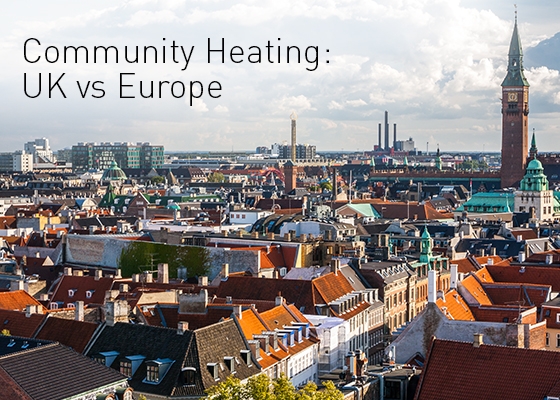

When it comes to creating and managing community heating schemes, there are lessons Britain can learn from its EU partners.
With our abundant oil and gas reserves, the UK has been relatively well insulated against some of the energy challenges faced by our continental neighbours.
Even so, there’s growing awareness of the lessons modern UK district heating schemes can learn from countries like Denmark and Austria, where ongoing investment has provided efficient and affordable district heating to millions of people
Situation on the ground
Although UK district heating is a new concept to many people, it’s been with us since those grand post-war plans for new communities were first drawn up. The Pimlico District Heating Undertaking went online in 1950, redirecting heat waste from Battersea Power Station into the new 1,600-property Churchill Gardens estate. These state-owned schemes were certainly grand but remained something of an occasional curiosity, unlike the all-encompassing projects in Communist countries and western European cities.
But over the last decade there has been a seismic shift in political and public support for UK district heating, spearheaded by dedicated funds for new systems from the Scottish Government and infrastructure loan guarantees provided by the Treasury. This is good news but our neighbours continue to lead the way…
European models
The 2004 Combined Heat and Power Directive enshrined European Union support for promoting cogeneration of energy, yet many countries have been championing district heating for decades.
Residents of Belgrade have enjoyed district heating since 1961, and this system has over 100 heat sources powering a quarter of a million homes today. While the EU’s 2012 Energy Efficiency Directive laid down requirements for metering and informative energy consumption billing, some member states were already largely compliant. Berlin residents, for example, have long been able to request free energy saving consultations if their district heating bills were higher than average. Modern Scandinavian district power stations can return as much as 90 percent efficiency, far outstripping today’s best UK cogeneration schemes.
The Copenhagen model
Perhaps the jewel in the crown is Copenhagen’s district heating system, inspired by the 1973 oil crisis and underpinning infrastructure investment that continues to this day. No less than 1,650km of pipework now connects ten CHP plants with heat storage installations and pumping stations, supplying 98 percent of the city’s heating needs. Central Copenhagen also benefits from a district cooling network, and connections are mandatory. Every building has a heat meter at the point of supply, with individual heat allocators provided to multiple end users for radiator-by-radiator reporting.
Copenhagen’s scheme also provides people with detailed information that encourages them to make energy-efficient decisions and minimise wastage. It’s a great way to create end-user awareness and another area where Britain lags behind its continental cousins. In this country, few individually-supplied properties contain an energy usage meter and sufficiently detailed billing information is rare.
Looking to the future
The Copenhagen system continues to blaze a trail for Europe’s district heating systems, and Copenhagen Energy is currently trialling remote meter reading. Indeed, the Danes want biomass to be their primary district heating fuel by 2025 – an ambition shared by our own politicians.
But with interest growing in new energy sources over here, the UK Government has become the first to incentivise renewable heat by offering payments to companies running commercial schemes using biomass boilers or solar/geothermal energy.
This is already feeding through on the ground with the first low-carbon UK district heating system being developed in Stoke-on-Trent, using geothermal heat energy to slash CO2 emissions and reduce energy costs by ten percent. Having already received £5 million of contributory funding from the EU, this is an ambitious (yet achievable) scheme that other European countries could learn a great deal from.
As the famous line from John Donne goes, “No man is an island entire of itself”. When it comes to district heating, the UK is finally warming up to its European partners.


